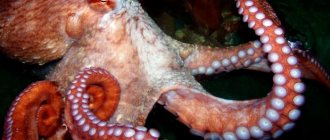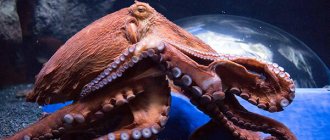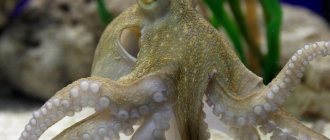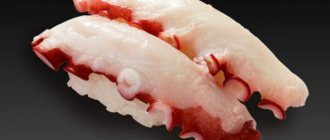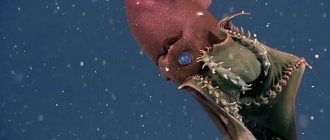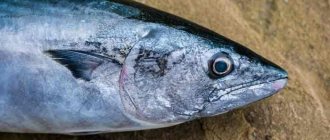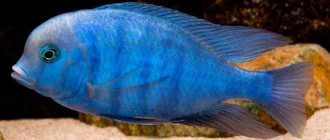- Where does the octopus live?
Octopuses are perhaps the most amazing of the mollusks that live in the depths of the sea. Their strange appearance surprises, delights, and sometimes frightens, the imagination pictures giant octopuses capable of easily sinking even large ships. This kind of demonization of the octopus was greatly facilitated by the work of many famous writers, for example, Victor Hugo described in his novel “Toilers of the Sea” octopus as “the absolute embodiment of evil.” In reality, octopuses, of which there are more than 200 species in nature, are completely harmless creatures, and it is rather they who need to be afraid of us humans, and not vice versa.
The closest relatives of octopuses are squid and cuttlefish; they themselves belong to the genus of cephalopods, the family of octopuses proper.
Description, structure, characteristics
The appearance of the octopus is confusing; it is immediately unclear where its head is, where its mouth is, where its eyes and limbs are. But then everything becomes clear - the sac-like body of the octopus is called the mantle, which is fused with a large head, and there are eyes on its upper surface. The eyes of an octopus have a convex shape.
The octopus's mouth is tiny and surrounded by chitinous jaws called the beak. The latter is necessary for the octopus to grind food, since they cannot swallow prey whole. He also has a special grater in his throat, which grinds pieces of food into pulp. Around the mouth there are tentacles, which are the true calling card of the octopus. The octopus's tentacles are long, muscular, and their lower surface is studded with suckers of varying sizes, which are responsible for taste (yes, the octopus's suckers contain its taste buds). How many tentacles does an octopus have? There are always eight of them, in fact, the name of this animal comes from this number, since the word “octopus” means “eight legs” (well, that is, tentacles).
Also, twenty species of octopuses have special fins that serve as a kind of rudders when they move.
Interesting fact: octopuses are the most intelligent among mollusks; the octopus' brain is surrounded by special cartilage, strikingly similar to the skull of vertebrates.
All the senses of octopuses are well developed, especially vision; the eyes of octopuses are very similar in structure to human eyes. Each of the eyes can see separately, but if the octopus needs to look at some object more closely, the eyes easily come together and focus on a given object, in other words, octopuses have the rudiments of binocular vision. Octopuses are also capable of detecting infrasound.
The structure of the internal organs of an octopus is unusually complex. For example, their circulatory system is closed, and the arterial vessels are almost connected to the venous ones. The octopus also has three hearts! One of them is the main one, and two small gills, whose task is to push blood to the main heart, otherwise it directs the flow of blood throughout the body. Speaking of octopus blood, it's blue! Yes, all octopuses are real aristocrats! But seriously, the color of octopus blood is due to the presence of a special pigment in it - geocyamine, which in them plays the same role as hemoglobin in us.
Another interesting organ that the octopus has is the siphon. The siphon leads into the mantle cavity, where the octopus collects water, and then, sharply releasing it, creates a real
a jet stream pushing his body forward. True, the octopus’s jet device is not as perfect as that of its relative the squid (which became the prototype for the creation of a rocket), but it is also excellent.
The sizes of octopuses vary between species, the largest of which is 3 meters long and weighs about 50 kg. Most species of medium-sized octopuses range from 0.2 to 1 meter in length.
As for the color of octopuses, they usually have red, brown, or yellow colors, but they can also easily change their color like
chameleons Their mechanism for changing color is the same as that of reptiles - special chromatophore cells located on the skin can stretch and contract in a matter of seconds, simultaneously changing color, and making the octopus invisible to potential predators, or expressing its emotions (for example, angry the octopus turns red, even black).
A little about octopus blood
Another exciting fact about these oceanic creatures is that their blood is far from red. Ah...blue. And this is not at all because they belong to “blue” blood. Everything is much more prosaic.
It was already mentioned above in the article that octopus blood is far from human in composition. If ours contains a large amount of hemoglobin, then theirs is rich in copper hemocyanin. Hemoglobin gives human blood its red tint. At the same time, copper colors it blue-blue. That's the whole solution!
Important! Copper-rich blood not only changes its color. It also allows octopuses to survive and exist deep in the ocean. They are able to easily obtain oxygen from the aquatic environment around them, even at very low temperatures.
Nutrition
Octopuses, however, like other cephalopods, are predatory creatures; their diet consists of a variety of small fish, as well as crabs and lobsters. They first capture their prey with their tentacles and kill them with poison, then they begin to absorb them, since they cannot swallow whole pieces, they first grind the food with their beak.
Giant Pacific octopus
The undisputed “heavyweight” among octopuses. The average weight of individuals is about 50 kg, but the largest specimen caught weighed 272 kg. The body length of the specimen is from 3 to 5 m.
Remember when we told you how smart octopuses are? It is this giant that takes pride of place in the ranking of the smartest animals. He knows how to solve puzzles, open doors to rooms and draw - a jack of all trades.
www.octopus.ru
These are the giants found in the waters of the World Ocean. Tell me, which of the octopuses impressed you the most? Leave your answers in the comments. Don't forget to subscribe to our channel and share links to publications with your friends. We will collect for you the most interesting information about the world of fish and seafood.
Danger to humans
Only on the pages of books or in various science fiction films, octopuses are incredibly dangerous creatures, capable of not only easily killing people, but also destroying entire ships. In reality, they are quite harmless, even cowardly; at the slightest sign of danger, the octopus prefers to retreat by flight, no matter what happens. Although they usually swim slowly, when in danger they turn on their jet engine, allowing the octopus to accelerate to a speed of 15 km per hour. They also actively use their ability of mimicry, merging with the surrounding space.
Only the largest species of octopus can pose some danger to scuba divers, and then only during the breeding season. In this case, of course, the octopus itself will never be the first to attack a person, but in defense, it can sting him with its poison, which, although not fatal, will, of course, cause some unpleasant feelings (swelling, dizziness). The exception is the blue-ringed octopus, which lives off the coast of Australia, whose nerve venom is still fatal to humans, but since this octopus leads a secretive lifestyle, accidents with it are very rare.
Southern giant octopus
The southern giant octopus is a desirable "prey" for scientists. So far, little is known about the creature that lives in the waters around Namibia and South Africa. Its approximate weight has been established - over 11 kg, with a body length of up to 2 meters. Unfortunately, the population of these individuals is declining every year. This is due to the fact that they are accidentally caught together with spiny lobsters.
x-perehod.ru
Types, photos and names
Of course, we will not describe all 200 species of octopuses; we will focus only on the most interesting of them.
Giant octopus
As you probably guessed from the name, this is the largest octopus in the world. It can reach up to 3 meters in length and up to 50 kg in weight, but these are the largest individuals of this species; on average, a giant octopus is 30 kg and 2-2.5 meters in length. Inhabits the Pacific Ocean from Kamchatka and Japan to the west coast of the USA.
Common octopus
The most widespread and well-studied species of octopus, living in the Mediterranean Sea and the Atlantic Ocean, from England to the coast of Senegal. It is relatively small, its body length is 25 cm, and together with the tentacles it is 90 cm. The body weight is on average 10 cm. It is very popular in the cuisine of the Mediterranean peoples.
Blue-ringed octopus
And this beautiful species of octopus, which lives off the coast of Australia, is also the most dangerous among them, since it is its poison that can cause cardiac arrest in humans. Another characteristic feature of this octopus is the presence of characteristic blue and black rings on its yellow skin. A person can only be attacked while defending himself, so to avoid trouble, you just need to stay away from him. It is also the smallest octopus, its body length is 4-5 cm, its tentacles are 10 cm, and its weight is 100 grams.
How long do octopuses live?
On average, the lifespan of an octopus is from 2 to 4 years. Biologists already consider four-year-olds to be long-livers. According to research, life expectancy may vary between species.
Some octopuses do not die a natural death: some males become victims of females. According to scientists' observations, sometimes females strangle their partners during sexual intercourse, possibly consuming them later as food. The mortality rate of the young generation is high: out of hundreds of thousands of small larvae, only a few individuals survive to puberty.
Reproduction
Now let's look at how octopuses reproduce; this process is very interesting and unusual. Firstly, they reproduce only once in their lives and this action has dramatic consequences for them. Before the mating season, one of the tentacles of a male octopus turns into a kind of sexual organ - a hectocotylus. With its help, the male transfers his sperm into the mantle cavity of the female octopus. After this act, the males, alas, die. Females with male reproductive cells continue to lead a normal life for several months, and only then lay eggs. There are a huge number of them in the clutch, up to 200 thousand pieces.
Then it lasts for several months until the young octopuses hatch, during which time the female becomes an exemplary mother, literally blowing away specks of dust from her future offspring. In the end, the female, exhausted from hunger, also dies. Young octopuses hatch from eggs completely ready for independent life.
Do three hearts always work at once?
Octopuses move along the bottom “on foot”, using their “arms”-tentacles. This method of transportation is much easier and more convenient for them than swimming. When they swim, their systemic heart shuts down. Without it, animals get tired very quickly, so they switch to “walking” again.
Important! The systemic heart also shuts down temporarily when the animal is very frightened. This is why you should not scare pet octopuses by tapping your fingers on the aquarium. In such cases, they freeze, turning off one of their hearts.
Interesting Facts
Frilly Pacific octopus
Scientists discovered this octopus just a few years ago, at the beginning of 2022. They considered the specimen to be the closest relative of the giant Pacific octopus. Externally, individuals differ markedly from each other physically and genetically.
8arm.com
The most striking feature of the frilled giant Pacific octopus is the frill of fused papillae present along the entire length of the body. Individuals also have a pair of white spots on their heads, while their closest relatives have only one.
Video
And finally, an interesting documentary about octopuses from National Geographic.
Author: Pavel Chaika, editor-in-chief of Poznavaika magazine
When writing the article, I tried to make it as interesting, useful and high-quality as possible. I would be grateful for any feedback and constructive criticism in the form of comments on the article. You can also write your wish/question/suggestion to my email [email protected] or Facebook, with respect, the author.
Author page
Casper the ghost octopus
Casper belongs to the Incirrina group of octopuses and is the deepest member of this species.
The so-called “ghost octopus” is a recently discovered species. Known for its pale, translucent body, it was first discovered by researchers near Hawaii in 2016 and is so new to science that it does not yet have an official name. Because of his resemblance to the cartoon character, the octopus was given the nickname Casper.
The unusual animal was discovered at a depth of 2.6 km - this is deeper than octopuses have ever been seen. Its pale appearance is due to a lack of pigment, and its gelatinous consistency is due to the difficulty of finding food and building muscle in the ocean depths.
Lifestyle
A solitary, territorial species, leads a benthic lifestyle, living among stones, rocks and algae. During the day, the octopus is little active; it hunts, as a rule, at dusk and at night. Timid, when a diver or scuba diver approaches, he usually hides under stones. Like most octopuses, the common octopus is afraid of men. It is tameable and never bites, even if provoked. He keeps his home clean: he sweeps it with a stream of water from a funnel, and puts scraps outside in a garbage heap. It drags into the hole everything it finds at the bottom: the main thing is that the entrance is narrow and wide inside.
It even lives in boxes, cans, tires and rubber boots. Becomes aggressive during mating. When enemies approach, it flees, hiding in rock crevices and under stones. Octopuses have a protective device - autotomy: a tentacle grabbed by an enemy can come off due to strong contraction of the muscles, which in this case tear themselves apart. It winters in deeper waters and moves to shallow waters in the summer.
Habitat
The common octopus lives in all tropical, subtropical seas and oceans (with a salinity of at least 30%), from shallow water to a depth of 100-200 m. It prefers rocky coastal zones, looking for caves and crevices in the rocks for habitat. In their natural habitat, octopuses are exposed to a wide range of temperatures, but their preferred temperature ranges from about 15 to 16°C. During particularly warm seasons, octopuses can often be found deeper than usual as they try to escape warmer layers of water.
